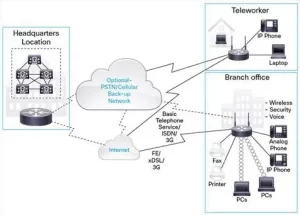In the intricate web of modern networking, two devices often spark confusion yet hold the keys to seamless connectivity: gateways and routers. While both serve as critical junctures in data transmission, their functions, use cases, and impacts on network performance differ dramatically. Choosing the right one isn’t about picking a “better” device—it’s about understanding your network’s unique DNA. This article demystifies these cornerstones of connectivity, empowering you to optimize speed, security, and scalability.
The Fundamental Divide: How Gateways and Routers Operate
At their core, routers and gateways manage data traffic, but their approaches diverge sharply.
- Routers: Acting as traffic directors, routers connect multiple networks—typically your local area network (LAN) to the wider internet. They use routing tables and IP addresses to forward data packets between devices, ensuring emails reach colleagues and streaming videos buffer seamlessly. Think of a router as a multilingual translator that helps devices on different networks communicate.
- Gateways: More versatile and complex, gateways operate as protocol converters. They enable communication between networks using different transmission protocols (e.g., TCP/IP to SNMP for IoT devices) or architectures (e.g., cloud to on-premises). A gateway might connect your office’s Wi-Fi network to a legacy industrial control system using Modbus, allowing real-time monitoring.
Example: A smart factory uses a router to link its LAN to the corporate WAN but deploys a gateway to integrate legacy machinery (using proprietary protocols) with modern IoT sensors.

Performance and Scalability: When to Choose Which
Scenario 1: Home or Small Office Networks
For most homes and SMBs, a router suffices. Modern routers like the ASUS RT-AX86U combine Wi-Fi 6 support, firewall protection, and QoS prioritization. They’re cost-effective (300) and user-friendly, handling tasks like:
- Assigning IP addresses via DHCP.
- Prioritizing Zoom calls over Netflix streams.
- Blocking malicious sites via DNS filtering.
However, add a smart home hub (e.g., Zigbee or Z-Wave devices) or a VoIP phone system, and a gateway becomes essential. The Cisco IR1101, for instance, translates between IP-based networks and industrial IoT protocols, ensuring your smart thermostat doesn’t “lose” commands.
Scenario 2: Enterprise or Industrial Networks
Enterprises with hybrid cloud setups or legacy equipment need gateways. Consider a hospital using:
- Medical devices (DICOM protocol) sharing data with EMR systems (HL7/FHIR standards).
- IoT wearables (Bluetooth) transmitting to cloud analytics platforms (HTTPS).
Here, a multi-protocol gateway like the Moxa MGate 5118 acts as a universal interpreter, preventing data silos. Routers alone can’t bridge these protocol gaps.
Security Implications: Guarding the Gates
Routers typically include basic security—firewalls, VPNs, and MAC filtering. But gateways offer deeper protection in heterogeneous environments:
- Industrial gateways (e.g., Siemens SCALANCE) segment OT and IT networks, blocking ransomware from jumping from email servers to production lines.
- API gateways (e.g., Kong Gateway) authenticate and encrypt data flows between microservices, thwarting man-in-the-middle attacks.
In 2022, a European auto manufacturer averted a $4M breach by using a gateway to isolate its CAN bus network from corporate IT—a feat impossible with routers alone.
Cost and Complexity Trade-offs
- Routers: Affordable (1,000), plug-and-play, but limited to IP-based networks.
- Gateways: Pricier (5,000+), require configuration expertise, but enable cross-platform integration.
Case Study: A retail chain upgraded to Wi-Fi 6 routers for faster checkout systems (12,000 on gateways to unify online inventory data (REST APIs) with in-store RFID tags (Proprietary RFID protocols). The result? A 30% reduction in stockouts.
Future-Proofing Your Network
With 5G, IoT, and edge computing reshaping connectivity, hybrid solutions are emerging:
- SD-WAN routers (e.g., Fortinet FortiGate 60F) now embed basic gateway functions, translating between MPLS and 5G links.
- AI-driven gateways (e.g., HPE Edgeline) predict traffic patterns, auto-converting protocols to optimize manufacturing workflows.

Leave a comment